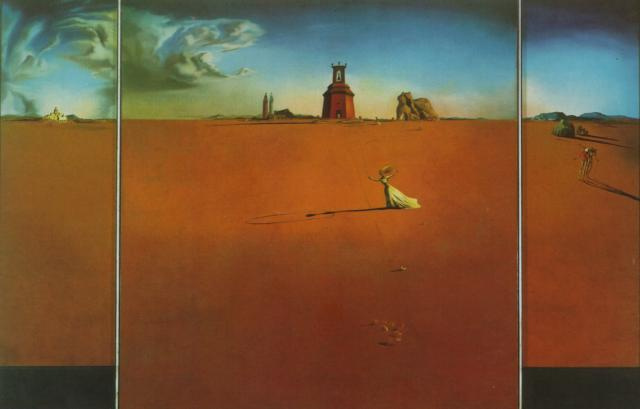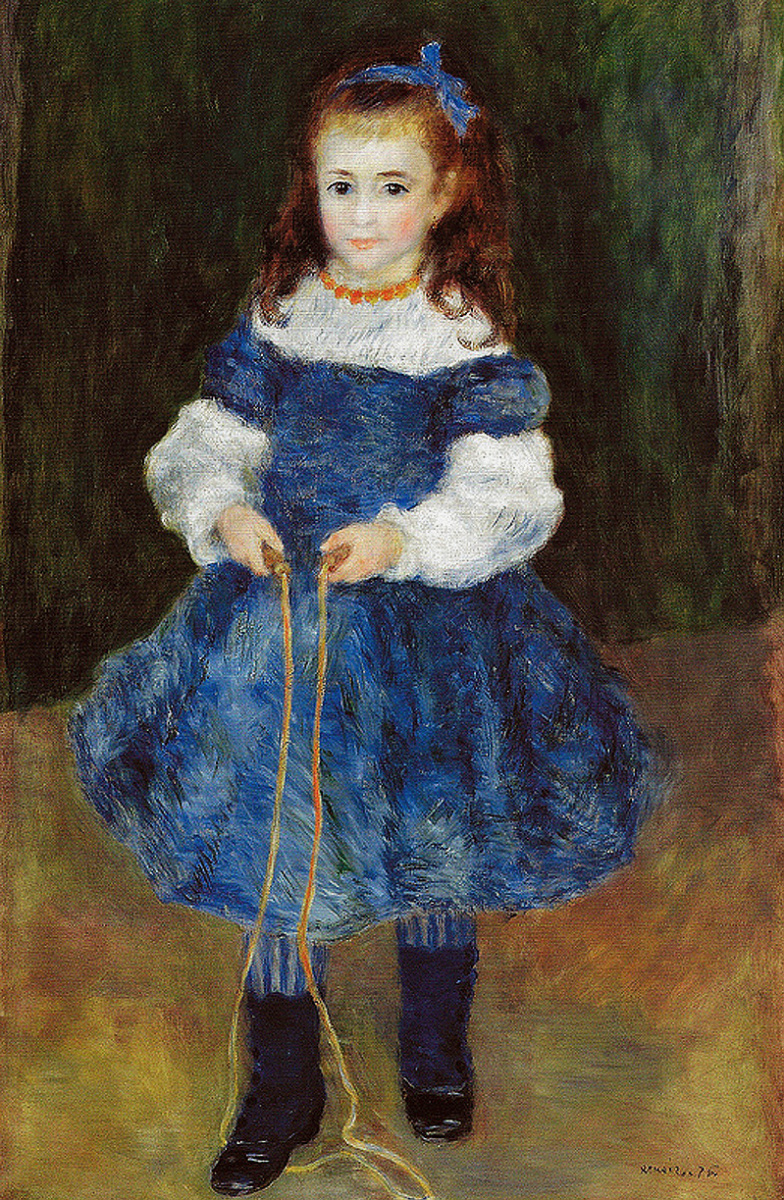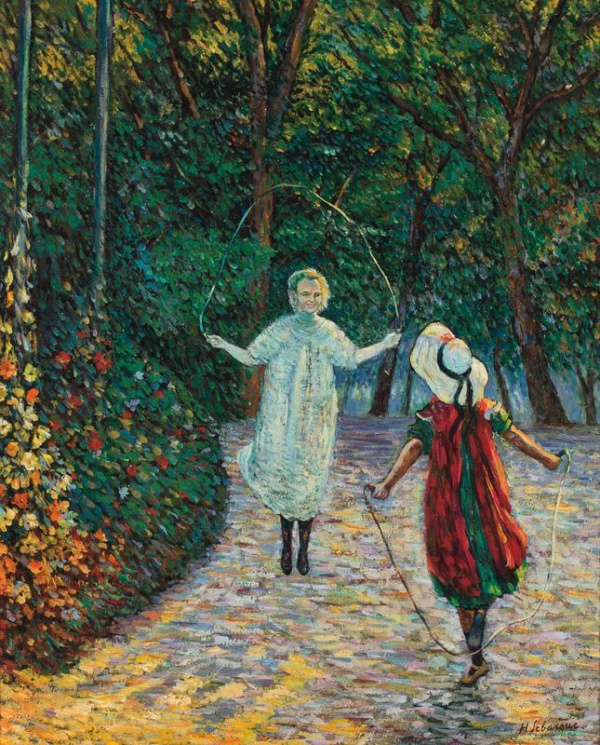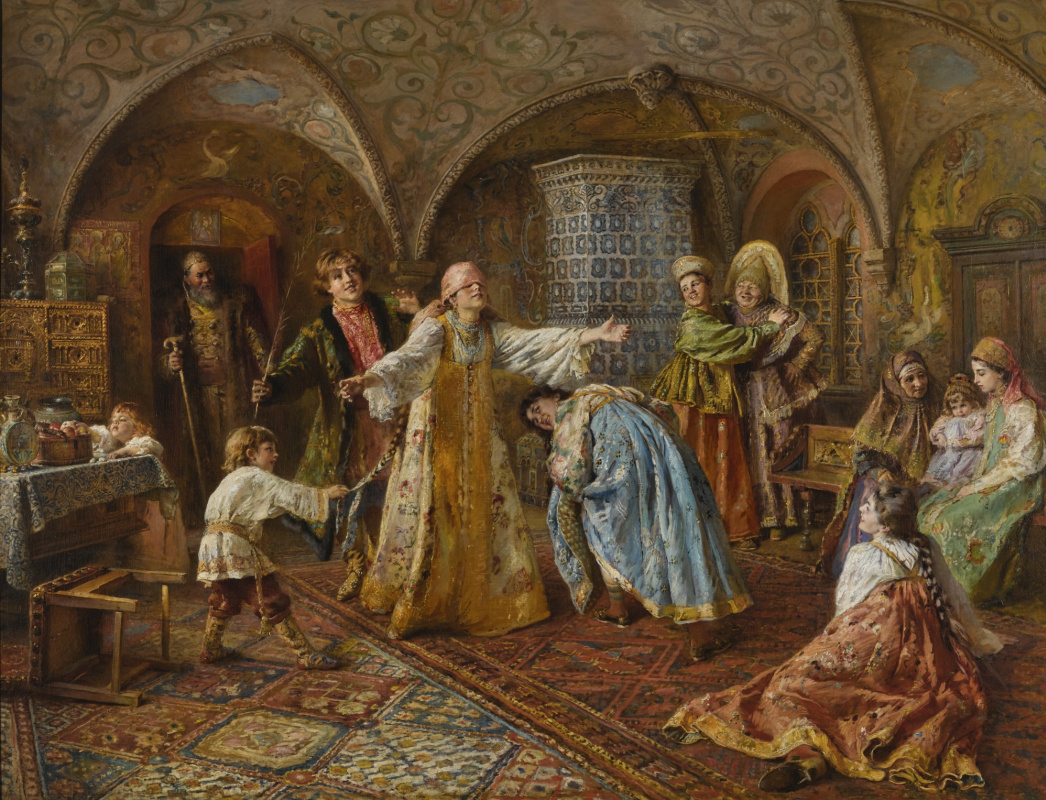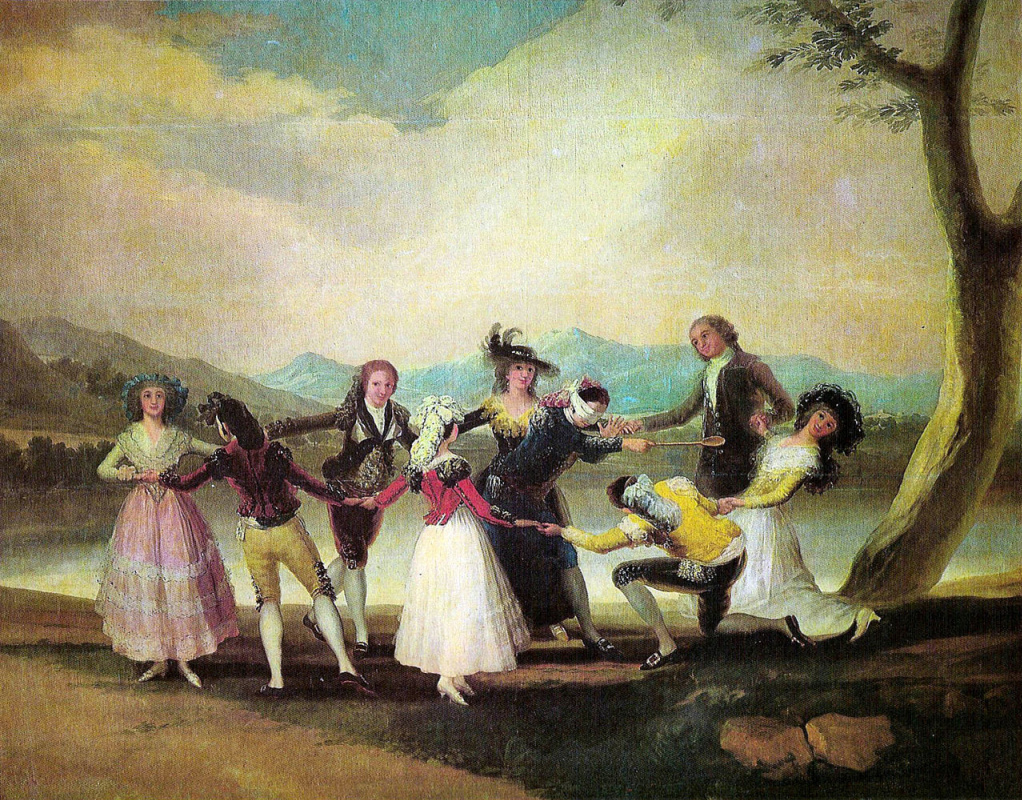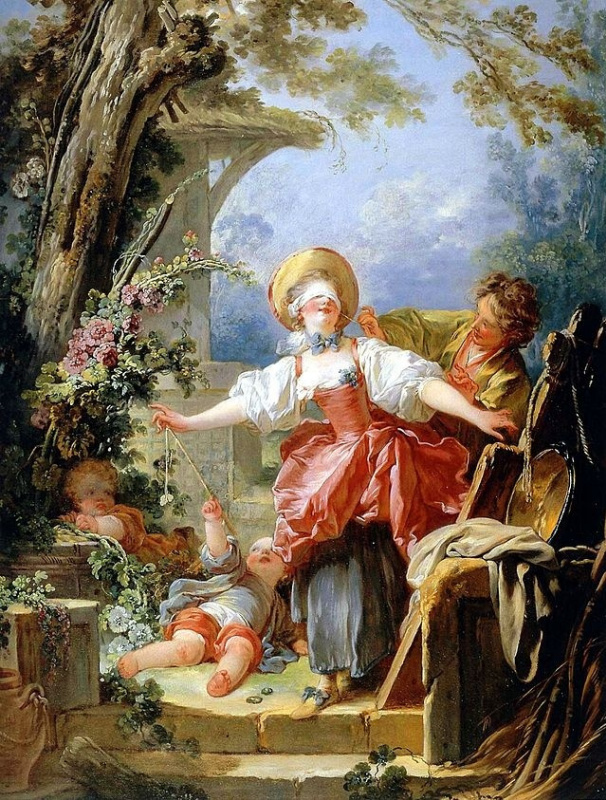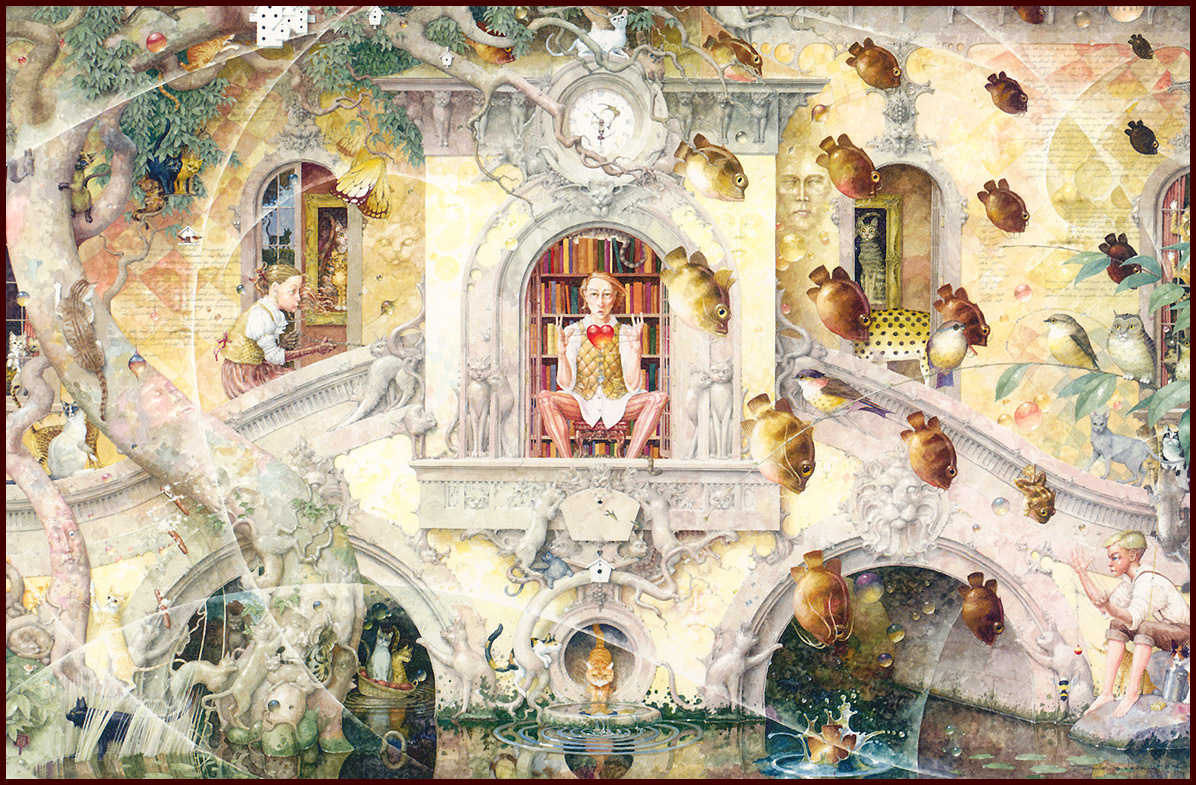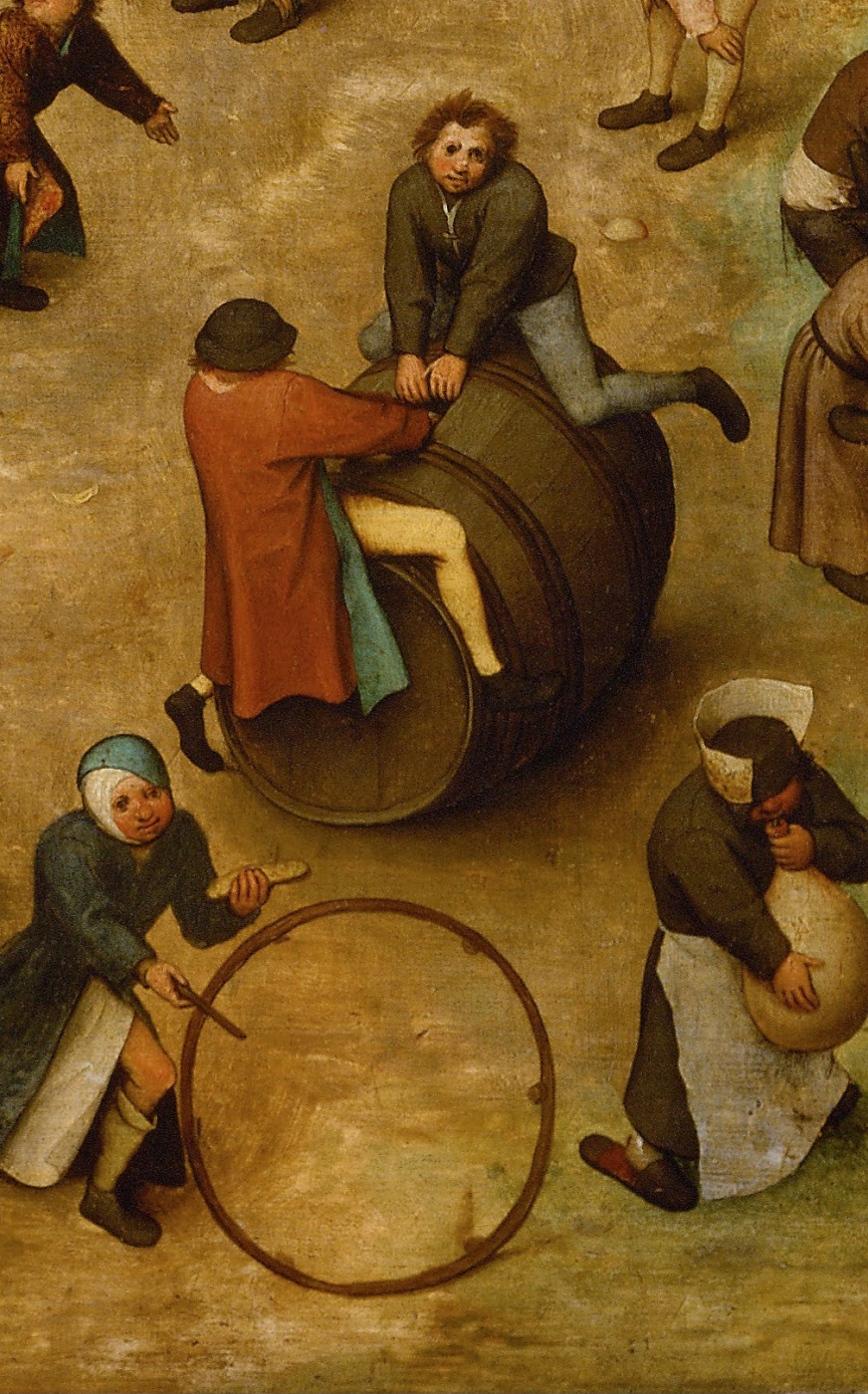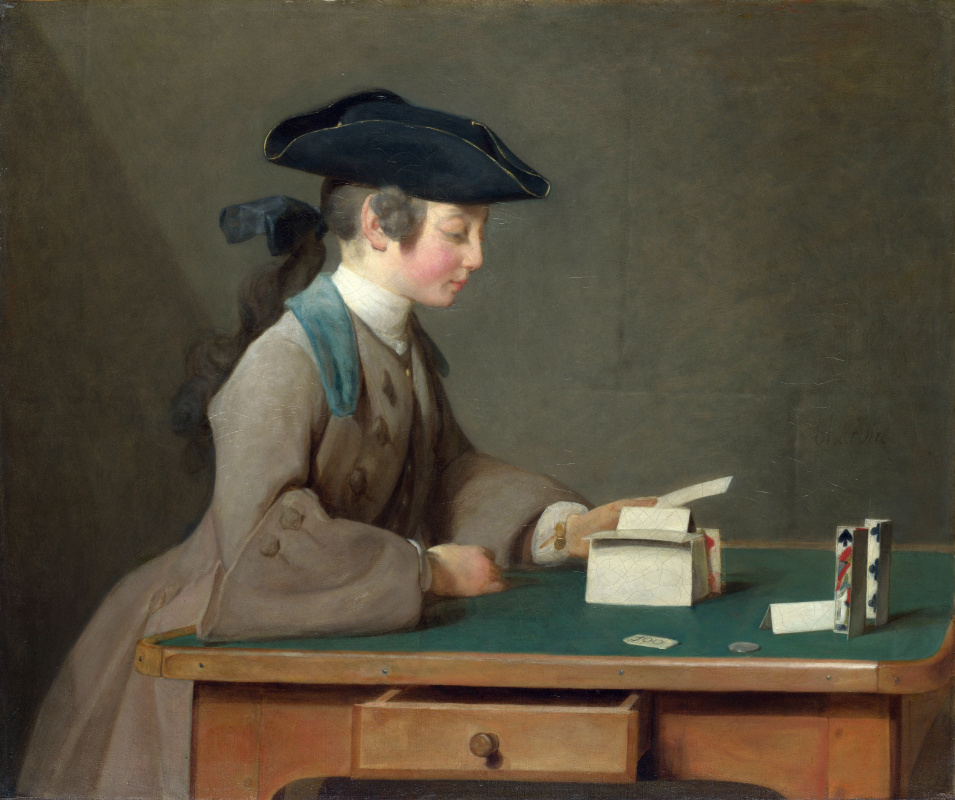In a store, a young woman bought a drawing-book with a bright glossy cover. She gave it to a child sitting in a baby stroller. The kid happily grabbed the album and began to tap on it with a finger. The picture didn’t change! The puzzled child turned the book around in the hands to look for buttons and handed that strange "device" to the mother, saying: "Mom! How?" "No, no! This is not a tablet," she said. "We'll draw with crayons at home." What other "old entertainments" are still relevant to adherents of smartphones and tablets? Let’s have a look at the games captured by different painters. All of them (games, not artists) share three characteristics: entertainment, simplicity of implementation and antiquity.

Bubbles
1739, 60×73 cm
A little soap in cold water
The history of soap bubbles goes back many centuries. Unfortunately, humanity has not accurately documented the act of blowing the first fragile colorful ball. But, as confirmed by archaeological excavations, people blowing bubbles through straws were depicted on the walls of the buildings even in ancient Roman Pompeii. For centuries, bubble blowers have been satisfied with the scheme: "soap solution — a straw — gently blowing air into it — a bubble." The production of special liquid for bubbles was established only in the second half of the 19th century in London. Nowadays, there’s a huge variety of both liquids and devices for the production of colorful bubbles, but the old method still remains fascinating for children. So, you can easily copy the subject of many canvases depicting this pastime at any moment.No other game has been depicted in as many paintings as bubble blowing. First of all, this is beautiful. And secondly, the bubble has become a symbol of a number of concepts, including the mutually exclusive ones. In the 17th century, appearing in the paintings of European masters, it represented the brevity of life and the suddenness of death. In the hippie culture, this rainbow-like, soaring object was a symbol of peace and harmony. Bubbles were also associated with childhood, joy and happiness.
Trying to figure out which of the symbols suit bubbles best may awake your child’s inner thinker. Or physics, and the search for answers to the questions "Is it possible to hold the bubble in your hands? What about freezing it? Why does the bubble change its color as it inflates?" will stir the future scientist into interesting discoveries, as happened, for example, to Albert Einstein. Or to Tim Kehoe. He spent ten years of his life and $3,000,000 to surprise the world with turning translucent bubbles into colored ones (they can be completely purple, blue, red, yellow and green). An artistic approach! The invention has become popular and let him recoup the money.

John Everett Millais A Child’s World (Bubbles), 1886
And those were bubbles that caused one of the first disputes on the topic "Are advertising and art compatible?" In 1886, English painter John Everett Millais completed his painting A Child’s World, in which he depicted his grandson James blowing bubbles. The picture was first bought by the owner of a major magazine, and later — by the head of the Pears soap company. They paid £2,200 (about $265,000 at current prices) for the painting. A year later, after lots of persuasion, the company managed to purchase copyright from the artist and immediately put their own logo on the picture. The artist’s colleagues got peeved.
And those were not only painters who were outraged at the situation: in her novel The Sorrows of Satan, Marie Corelli accused John Millais of prostituting his talent. The little subject of the painting, the artist’s grandson, also got it bad. Even though he rose to the rank of admiral in the Royal Navy, he was known as "Bubbles" for the rest of his life.
Bubbles also made it to the Guinness Book of Records. The biggest bubble, 32 meters long, was created by Alan McKay in 1996. In 2007, Sam Heath put 50 people inside a giant bubble. Its size was 1.5×3.3 m.
Bubbles also made it to the Guinness Book of Records. The biggest bubble, 32 meters long, was created by Alan McKay in 1996. In 2007, Sam Heath put 50 people inside a giant bubble. Its size was 1.5×3.3 m.
Not only for girls
In painting, these are usually girls who are depicted with jump ropes. Salvador Dalí said that his women with jump ropes symbolized the rebirth of the soul. However, girls started to skip rope much later than boys. In Europe, until the end of the 18th century, jump rope was considered an entertainment only for males.The most plausible version of the appearance of the jump rope game is that the rope itself and all the games that can be played using it, came from ancient China. Workers twisted ropes, occasionally jumping over them. As it happens, what bothers adults is fun for children. And later the adults also join them. Jumping rope later became an indispensable attribute of the Chinese New Year festival. As for Europe, a jump rope was appreciated the earliest in the Netherlands. The British, watching rope games, contemptuously called them Double Dutch. Contemptuously, because in the 16th century, the British considered everything Dutch to be of little mark. Military rivalry on the water does not contribute to active intercultural exchange. Nevertheless, jump rope still won over both Europe and America, turning from children’s game into a popular sports attribute.
Girl with skipping rope
1876, 107.3×71 cm
In the 19th century, girls also started to jump rope. In the same century, the most common types of games with jump rope were created: a child rotates the rope on their own and skips over it; two children rotate the rope while the third one is jumping; two children rotate two jump ropes simultaneously in different directions; the child spins the rope on the ground while other children form a circle and jump over it.
Dangerous weapon that has become a toy
The kite came to us from the East, where back in the 5th century BC, it had participated not in children’s games but in the wars. According to an ancient legend, a famous Chinese general Han Hsin put the enemy troops to rout by flying the kite with harps fitted to it over the hostile camps at night. The enemies fled, thinking that they were attacked by evil spirits. And in the ancient Korean lists, it is said that one general in ancient times flew a kite with a lantern attached to it, in order to instill courage into his warriors. They believed that it was a new star, which augured them help from heaven. Kites also participated in the later wars, including the European ones. That’s why these are often adults who are flying kites in the pictures. One of such processes of flying a kite was painted by Francisco Goya.
Kite
1778, 269×285 cm
In Japan, flying a kite was associated with religion and showed the connection between heaven and earth, between the man and the gods. This symbolic meaning is often typical of snakes in the paintings.
In China, it is believed that flying a kite brings happiness. According to one legend, a kite saved the whole family from death. The head of the family had a terrible dream of the inevitable demise. In the morning, he decided that the best way to say goodbye to his life was to fly a kite. But nothing unusual happened during the process — only a childlike delight. But when the family returned to their home, it turned out that the house was destroyed by a mudslide that had descended from the mountains. In honor of this miraculous rescue, the Chinese are now organizing a kite festival every ninth day of the ninth month.
In China, it is believed that flying a kite brings happiness. According to one legend, a kite saved the whole family from death. The head of the family had a terrible dream of the inevitable demise. In the morning, he decided that the best way to say goodbye to his life was to fly a kite. But nothing unusual happened during the process — only a childlike delight. But when the family returned to their home, it turned out that the house was destroyed by a mudslide that had descended from the mountains. In honor of this miraculous rescue, the Chinese are now organizing a kite festival every ninth day of the ninth month.
Kite
1880-th
, 38×12 cm
"You're it!"
"Blind Man’s Buff", "Blind Tom", "Hide and Clap" - it’s far from a complete list of the names of the same game, in which the player chosen to be "it" is blindfolded and spun around several times before being challenged to capture another player, following the sounds.As you can see from the pictures by the old masters, this game had not been considered appropriate only for kids for a long time. Three hundred (and even more) years ago, ladies and gentlemen hadn’t invented the spin the bottle game, so instead of kissing, they were content to touch the object of their passion while playing.
The many names of the cat's cradle
The name of the game — Cat’s Cradle — was made known all over the world by Kurt Vonnegut’s novel of the same name. And the game itself is several centuries (some anthropologists believe that several millennia) old. However, it is known in different countries under their own names. In Germany, it is called "Hexenspiel" (witch's game), in Hawaii — "hei" (net), among the Slavs — "nitochka" (string) and on Easter Island — "Kai Kai" (string figure). Wherever people weave threads, this game is played. Most often it is played by two people, but it’s possible to involve more players. The point of the game is to remove the strings from your partner’s hands over to your own fingers while creating a new pattern.Kurt Vonnegut wasn’t the only one who wrote about the "Cat's Cradle." In 1906, American ethnologist Caroline Furness Jane published the book Figures from a Thread, and How to Make Them. In 1962, the book was reprinted. It describes in detail more than a hundred string patterns.
But people did not stop there. In 1978, the International String Figure Association was formed. It’s goal is to preserve and spread knowledge about the game.
But people did not stop there. In 1978, the International String Figure Association was formed. It’s goal is to preserve and spread knowledge about the game.
Concert
XX century, 89.5×116.3 cm
A hoop and a stick
This game also has a lot of names, but the most common one is Hoop rolling. It was played in ancient China and in ancient Greece. The game was recommended by Hippocrates for "strengthening weak constitutions". You can strengthen in three standard ways — either roll the hoop, pushing it with a stick and making sure that it does not fall; toss the hoops back and forth, catching them on the sticks; or spin the hoop on a stick in front of you, trying to maximize the rotation.
Children's games. Fragment 17
1560, 118×161 cm
Depending on the chosen variant, the hoop was made of either wood or iron. The ancient Greeks rolled bronze hoops. By the way, the very popular hula hoop also originates from this old game.
The umbrellas
1886, 115×180 cm
House of cards
Back in the 1730s, Jean-Baptiste-Siméon Chardin created a series of paintings in which people were depicted building houses of cards. However, it has not yet been clearly identified when and who first came up with the idea of building such houses and even castles. The earliest mention of the house of cards is found in the notes of the French court physician Jean Aruard (early 17th century). The doctor stated that King Louis XIII, as a child, liked to place cards on top of each other, keeping proportions.
House of cards
1737, 60.3×71.8 cm
Building houses of cards reached its peak of popularity in European middle-class families in the 18th century. While the adults were having table-talks, the children made castles from playing cards. If you get creative enough, you can come up with lots of games with houses of cards. For example, who can build the tallest house? Whose card at the joint construction will be the last, making the paper building collapse?
Already at the beginning of the 20th century, house of cards building records were set and recorded. In 1902, an Englishwoman by the name of Rosie Farner built a house of cards of twenty stories. The current world-record holder is Bryan Berg, whose achievements are noted in the Guinness Book of Records. Berg has been building record-holding houses of cards since 1992 and so far he is second to none.
Already at the beginning of the 20th century, house of cards building records were set and recorded. In 1902, an Englishwoman by the name of Rosie Farner built a house of cards of twenty stories. The current world-record holder is Bryan Berg, whose achievements are noted in the Guinness Book of Records. Berg has been building record-holding houses of cards since 1992 and so far he is second to none.
House of cards
1919, 65×75.5 cm
In lieu of an epilogue
The first person who took a look at the text about the games was my 6-year-old son.— Well, I played all of this, — and I even have a special board game for building houses of cards. The only thing I’ve never heard of is a cat’s stroller.
— Cat's cradle, — I corrected.
— Oh, right. I’d like to play it.
In order to demonstrate several patterns of the game, I involved my elder son.
— Wow! — the child was amazed. — It's really interesting! Can I do that?
We spent about an hour learning the basics, and then we played the cat’s cradle. After playing, the child asked:
— Mom, why didn’t you show me this before? It’s about your favorite development of fine motor skills.
— To be honest, I simply forgot about this game, — I answered honestly. — Writing the text brought it back to my memory.
— See, how useful your job is?










